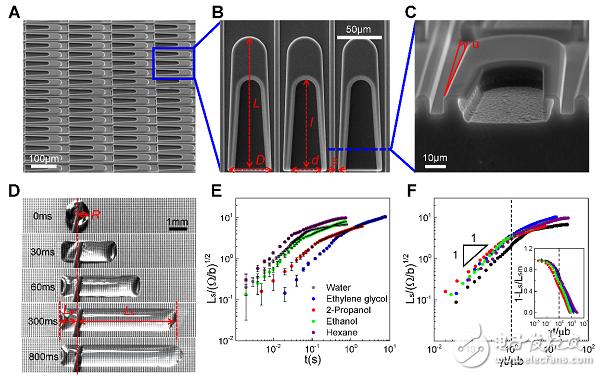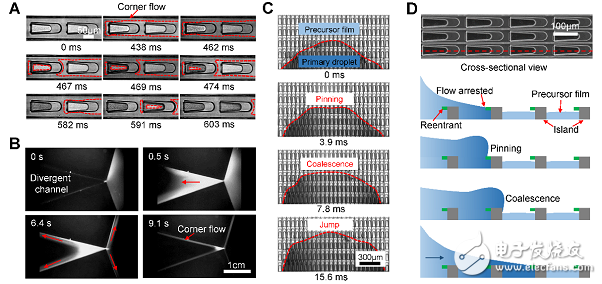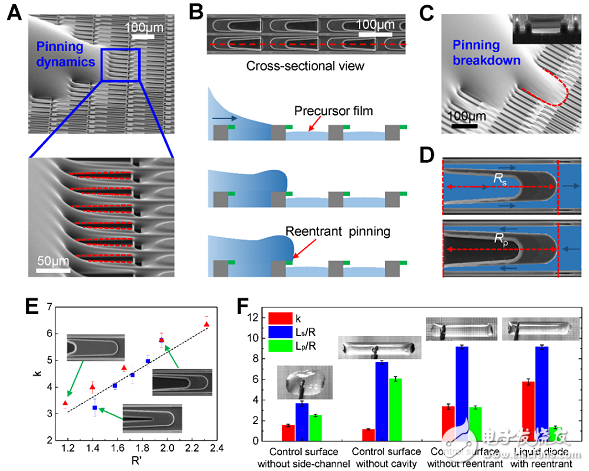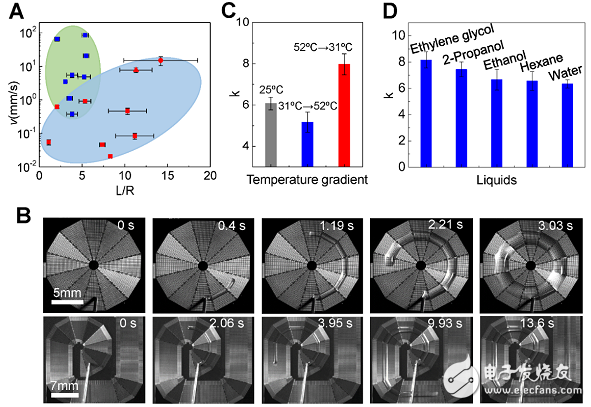Interpretation of Topological Fluid Diodes in Various Industrial Production Application Technologies
Liquid directed self-transportation has important applications in the fields of energy, microfluidics, oil-water separation and water collection. Conventional liquid one-way transport requires the input of external energy to break the symmetry of the liquid flow and overcome the pinning effect caused by structural surface defects. There are many animals and plants in nature, such as pitcher plants, cacti, desert beetles and lizards, who can subtly rely on the special microstructure of their surface to control the orienteering of droplets to survive in harsh environments. However, the actual engineering application conditions are complex, involving complex interfaces and multi-phase transition processes. In this way, how to develop an artificial material system that can transcend nature and achieve directional non-driven, long-distance transport in a wide-spectrum temperature field is currently the main challenge.
In the field of droplet self-transport in the longitudinal direction, a key scientific and engineering issue is how to design and develop new biomimetic materials to break the physical limits of the dynamic contact time inherent in solid-liquid interfaces. The traditional super-wetting material (the lotus leaf effect) is mainly based on the micro-nano structure, and the mechanical properties are fragile, and the outdoor weather resistance, chemical stability and moisture-heat resistance are poor, and it is difficult to process. The Wang Drilling team developed an unconventional super-wetting system based on the sub-millimeter scale. For the first time in the world, the phenomenon of droplet-like bounce of super-hydrophobic surfaces was discovered. The dynamic model of droplet movement was established to reveal that the colliding droplets did not shrink. The mechanism has subverted the conventional understanding of the dynamic contact of solid-liquid interfaces for 130 years. Based on this model, various sub-millimeter unconventional super-wetting surfaces were designed to reduce the physical limit of contact time between droplets and super-wetting surfaces by 80% (Nature Physics, 2014, 10, 519, Ref. [1]). This work is also reported as a highlight in Nature Physics. In addition, based on the inductive surface structure of Jade Lotus, a wave-shaped millimeter-scale variable arc bionic super-wetting surface was developed, and the theory of asymmetrically bounce of super-wetting surface droplets was proposed, which shortened the theoretical limit of solid-liquid contact time by more than 40%. (Nature CommunicaTIons, 2015, 6, 10034, Ref. [2]). At the same time, the combination of the lotus leaf effect and the Nepenthes effect reveals the physical mechanism of the lotus-like effect on liquid films (Nature CommunicaTIons, 2015, 6, 10034, Ref. [3]) for the development of unconventional hyperinfiltration. The surface provides new ideas.
In the research field of droplet self-driven transport in the lateral direction, Wang Drilling team system studied how to control the surface wettability and patterning to realize the transmission and energy conversion of droplets under complex conditions. At low temperatures, they proposed a strategy to simultaneously enhance the film-like and droplet-like condensation, successfully developed a promiscuous hybrid micro-nano structure, synchronously accelerated droplet formation and self-displacement, and greatly improved surface heat transfer efficiency (Advanced FuncTIonal Materials, 2011, 21, 4617, cover, ref. [4]; ACS Nano, 2015, 9, 71, cover, ref. [5]). Among the work on Advanced FuncTIonal Materials, the editors of Nature Physics commented on the long-term most creative research work in the field of surface engineering. At high temperatures, in view of the low heat transfer efficiency caused by the Leidenfrost phenomenon in high temperature conditions, the asymmetric surface structure is skillfully designed, and the surface structure and temperature bidirectional regulation are used to induce droplet transfer to a region with high heat exchange efficiency. Avoid boiling problems in heat transfer (Nature Physics, 2016, 12, 606, Ref. [6]). At room temperature, based on the self-folding effect of mimosa, a non-source-driven film was developed, and the liquid can be quickly spread in one direction (Science Advances, 2016, 2, e1600417, Ref. [7]), which was performed by Nature and Nature Physics. Reported as a research highlight.
[Introduction]
Recently, the research team of the City University of Hong Kong has made breakthroughs in the field of micro-nano bionic surface liquid drive. The research results were published on October 27, 2017 in the Science Journal of Science Advances (2017, 3, eaao 3530, Ref. [8]) under the heading "Topological Liquid Diode". The City University of Hong Kong is the first completion unit. The cooperation units include the Shanghai Institute of Microsystems and Information Technology of the Chinese Academy of Sciences, China University of Petroleum (East China), the University of Northumbria, and the University of the Caspian. Associate Professor Wang Dangkai from the City University of Hong Kong and Professor Manoj K. Chaudhury from the University of Lehigh, USA, are the authors of the paper. In addition to a series of advances in the field of mechanical bionics such as unconventional super-wetting material systems and liquid self-transportation, Wang Drilling Research Group has also carried out a series of studies in the fields of anti-icing, anti-fouling and surface adhesion.
[This article highlights]To achieve long-range, directional, self-driven transmission of fluids, we introduced the concept of a topological fluid diode. By designing a unique micro-nano structure, the flow resistance in one direction is reduced, and the flow resistance in the opposite direction is increased, and the two are perfectly combined without interfering with each other, thereby realizing long-distance liquid self-driven transmission. The fluid diode breaks through the transmission length limitation of the previous wetting gradient drive and the spreading speed limit driven by the asymmetric structure, which greatly improves the efficiency of liquid directional transmission. The fluid diode has a wide range of versatility and stability, and can transport liquids of different properties (low surface energy liquid and highly viscous liquid), can transport liquid along different paths, can overcome liquid gravity transfer, and even overcome temperature gradient transmission. . Such superior performance makes it have great application prospects in the fields of heat and mass transfer, multiphase flow, water collection, liquid transport, microfluidics, biomedicine, and electronic cooling.
[Graphic introduction]Figure 1: Design and characterization of fluid diodes

(A) Electron micrograph of a fluid diode
(B) Electron micrograph of microstructure
(C) "Mushroom head" structure on the inner edge of the microstructure
(D) One-way transmission of a single droplet on a fluid diode
(E) Transmission mechanism of liquids of different properties on fluid diodes
(F) Transport mechanism of different properties of liquids on fluid diodes after treatment
Figure 2: Microscopic spreading mechanism of fluid diodes

(A) The spreading process of the precursor film
(B) Angular capillary effect in the side channel
(C) The spreading process of the droplet body
(D) Schematic diagram of the process of droplet body spreading
Figure 3: Tightening mechanism and comparison test of fluid diodes

(A) Electron microscopic picture of fluid diode liquid pegs
(B) Schematic diagram of fluid diode liquid pinning
(C) Electron microscopic picture of surface liquid-pinning without "mushroom head" microstructure
(D) Fluid resistance in both directions
(E) Effect of different microstructure chamber sizes on fluid diodes
(F) Fluid Diodes and Comparative Tests
Figure 4: Generality of fluid diodes

(A) Comparison of fluid diodes with existing liquid self-driving surfaces
(B) Fluid diodes directionalally transport liquids against temperature gradients
(C) Fluid diodes transport liquids of different nature
(D) Fluid diodes transport liquid on different paths
Product categories of Cloth Pen Nib, it is belong to Passive Stylus Pen. Passive stylus pen is characterized by being cheap and without charging. But compared with the active capacitive stylus pen, its tip diameter is larger, so it cannot be used in works with high precision. Using high-quality conductive cloth head, smooth contact with the screen.
Cloth Pen Nib,Multi-Functional Pen Stylus Pen,Stylus Pencil With Clip,Touch Stylus Pencil
Shenzhen Ruidian Technology CO., Ltd , https://www.wisonen.com